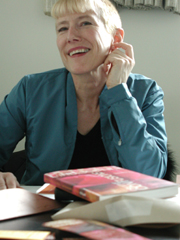
Lynn Hughes’s new
book is Creative Con/fusions.
Photo by Christian Fleury
|
by James Martin
Lynn Hughes is, by her own tongue-in-cheek admission, “a weird person”
— at least, she has an unusual academic profile.
She’s a visual artist with an MA in the history of mathematics. She’s
a painter currently working in video. She’s a teacher who spends
countless hours writing grant applications. In short, she’s the perfect
person to edit a book about interdisciplinarity in contemporary art.
“My whole life is about mixture,” says the Concordia painting
instructor, who just celebrated the publication of Creative Con/fusions:
Interdisciplinary Practices in Contemporary Art. Hughes is co-editor
of Creative Con/fusions with Marie-Josée Lafortune, artistic director
of the artist-run Optica, a centre for contemporary art in Montreal. She
says it’s the first book to specifically address interdisciplinarity
in terms of visual art.
Much ink has been spilled on the topic of interdisciplinarity, “but
not in terms of art. Still, we use the word ‘interdisciplinarity’
all the time as if we all understand what it’s about. A lot of artists
are sick of the word because they think it sounds too academic —
it has a sense of a stodgy definition, without actually being very well-defined.
It’s such a powerful word, an attractive word, but it’s ambiguous
and semi-empty half the time.”
Inspired by discussions at a 1996 conference, Hughes and Lafortune set
to work on Creative Con/fusions with a two-pronged purpose: to
simultaneously rescue the nebulous buzzword from stodginess, and to give
it more definition. They prepared by reading classic texts on interdisciplinarity
to learn “how the word is used in other disciplines, then to ask
how it is used in art.
“Interdisciplinarity in pretty much all other disciplines consists
of making a progressive use of other disciplines, where you make sure
that you’re using the latest stuff. If, for example, a biologist
crosses over into economics and uses some outdated theory, most of the
time that wouldn’t work. Interdisciplinarity is progressive in the
sense of trying to get somewhere that’s the next step along the way,
to get a more sophisticated view.
“But in art, you can ‘raid’ other disciplines without necessarily
being up-to-date. Because you’re not trying to progress in the scientific
sense, you can use those things in a much freer way; you use them for
their metaphoric or aesthetic qualities.”
Hughes says that more and more artists are moving away from the single-minded
idea of the artist as cloistered loner. Artists are “reading voraciously”
on non-artistic subjects (Hughes, as an example, has drawn on her MA studies
to create a series of paintings incorporating photos and mathematical
equations). Canada’s network of artist-run galleries encourages artists
to gain skills (such as Web design) that “are not necessarily skills
that artists bothered with 50 years ago. Since the ’70s, we’ve
become used to running things, to having these multiple skills.”
As an initial foray into the topic, Hughes calls Creative Con/fusions
“a dip into the bucket, although it’s a fairly structured dip.”
She and Lafortune began the project by spending six months wrestling with
ideas of approach and representation (“Should we have one person
from each province? Half men and half women?”), before settling on
a cross-section of visual artists, teachers, curators, and art historians
they hoped would “attack interdisciplinarity from different angles.”
The resulting book is a mixture of essays and long definitions, each presented
in the author’s original language (half are English and half French
— a happy accident in keeping with the book’s spirit) with a
short bilingual summary. The four definitions range from the traditional
(Concordia professor Tim Clark’s academic history of the word) to
the oblique (UQAM professor Nicole Jolicoeur’s “very dense,
poetic text that doesn’t mention the word anywhere”).
The nine essays are an equally diverse mix, tackling issues of pedagogy,
artistic practice, curatorial challenges, and art history. In their preface,
Hughes and Lafortune conclude that the selections reveal interdisciplinarity
to be “a lumpy, awkward beast” — a phrase that captures
both the vastness of the “bucket” being explored, as well as
the sense of “intelligent playfulness” (not stodginess) that
Hughes believes is crucial to art.
Creative Con/fusions was four years in the making, and Hughes is
understandably thrilled to finally see it on bookstore shelves. Still,
she admits she “can’t resist moving right along” and —
as befits a Renaissance woman — has many projects on the go. In addition
to teaching, she’s working with graduate students on a multi-year
interactive video project.
Hughes also sits on the board of directors for Hexagram, the Concordia/UQAM
media arts and technologies institute which just received, in December,
a whopping $21.9 million from the Canada Foundation for Innovation. On
top of all that, Hughes already has an idea for a new book. She’s
not entirely happy about this latter development.
“I feel that technology is really doing things to contemporary art
that accelerates interdisciplinarity,” she says, “so it would
be really interesting to focus a book on that — but I’m hoping
not to be tempted to do it. I just have so many other things going on
that I want to concentrate on!”
|
|
|



